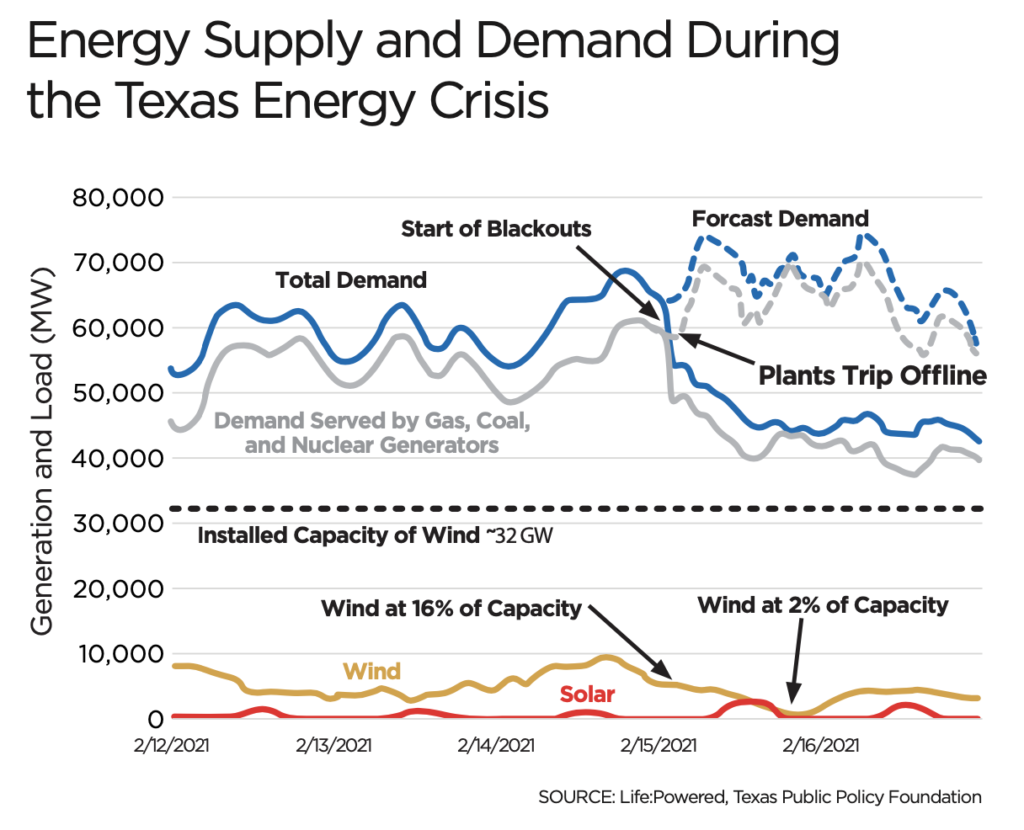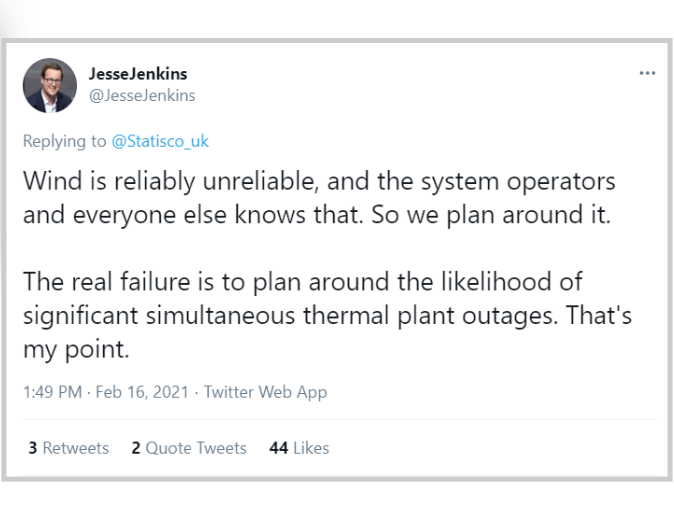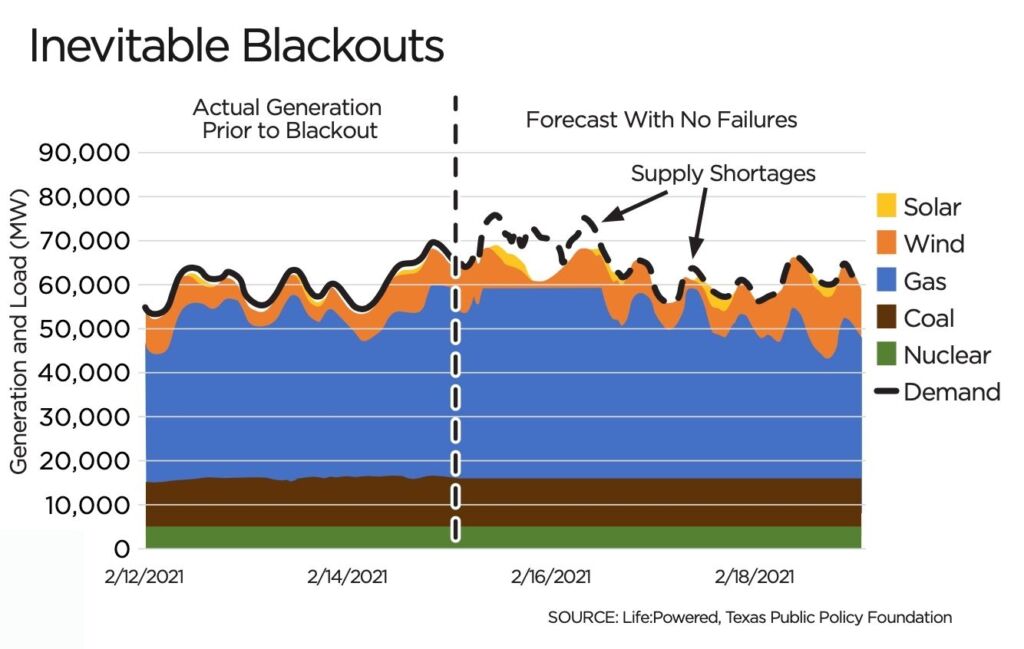Black out
What Minnesotans can learn from rolling blackouts and government favoritism for wind and solar.
In mid-February, more than 4.5 million families in Texas suffered through a week of rolling power outages due to inadequate electricity supplies.
Rolling power outages also affected millions in the Southwest Power Pool (SPP), a regional electric grid that contains portions of 14 states spanning from North Dakota to New Mexico, including small portions of Minnesota.
The effect these blackouts had on the lives of residents of these states ranged from inconvenient to deadly.
As of Feb. 21, more than 40 people in Texas had died from the power outage, according to ABC News. At least five people had died of carbon monoxide poisoning by trying to keep warm using grills or running cars inside closed garages — two of them were a mother and child.
Another tragedy involved an 11-year-old boy named Cristian Pineda. He died of hypothermia after his family’s mobile home lost power and heat for two days during the freezing weather. His death is heartbreaking, and it was unnecessary.
The human cost of the blackouts goes far beyond the number of people who passed away. Millions of people woke up without access to safe drinking water — 14 million, to be exact. Multiple days of below-freezing temperatures caused water pipes to burst, resulting in flooding in many homes and businesses. Broken systems also left millions without any water at all.
Blackouts are also devastating economically. In Texas, insurance adjusters believe the deep freeze could cause $18 billion in damages, and result in more insurance claims than any previous weather event in the history of Texas. More than Hurricanes Harvey, Ike, or Rita.
These insurance claims don’t even begin to consider the enormous $7,000 to $17,000 electric bills some families in Texas are receiving, or the lost productivity in the Texas economy that was exacerbated by the blackouts.
The news from Texas and other states left many people wondering: What caused the blackouts and how can we make sure they never happen in Minnesota?
What the hell happened in Texas?
The most obvious reason for the blackouts in Texas is there was not enough electricity supply on the grid to meet demand.
Demand surged on Feb. 15 as freezing temperatures enveloped the state. Unlike Minnesota, where roughly 66 percent of households heat their homes with natural gas and only 17 percent use electricity, Texans rely on electricity for 61 percent of their home heating and 35 percent use natural gas.
The most important thing to know about the electricity system is that the supply of electricity must always match demand within a very narrow band of frequency.
It’s a little like the process of turning the dial on an FM radio, for those who remember them, to get the clearest signal. Turning the dial too far in either direction causes the sound to get fuzzy, turn it even further and the channel is changed entirely.
In the United States, the electric grid operates at a frequency of 60 Hertz. If the demand for electricity on the grid outstrips supply, it causes the frequency to dip. As the frequency dips, the power plant equipment that is designed to operate at a specific threshold can sustain permanent physical damage that would make blackouts even worse.
To prevent this damage, power plants have built-in safety mechanisms that cause them to “trip” offline or disconnect from the grid. Unfortunately, “each generating plant that goes offline to avoid damage puts more stress on those that remain, causing them to go offline one at a time,” according to Bloomberg. These factors led to an accelerating cascade of outages.
Unmet demand
Cold temperatures led to a surge in demand for electricity, but this need was not met for a multitude of reasons.
One reason is that the natural gas production system in Texas is not designed to operate in such frigid temperatures. According to The Texas Tribune, natural gas production fell from 24 billion cubic feet per day to between 12 and 17 billion.
Falling production reduced the amount of gas available for power plants, and there were multiple instances where natural gas supplies were diverted away from power plants to be used for heating at homes, businesses and hospitals. Lastly, falling wind speeds led to a significant drop-off in electricity production from the Texas wind fleet. At some points during the Polar Vortex, wind was producing just two percent of its potential output.
This confluence of factors led the frequency on the grid to fall below the stable threshold for operation, causing some natural gas and coal-fired power plants to trip offline, making the blackouts worse than they needed to be.
The Electric Reliability Council of Texas (ERCOT), which operates most of the state grid, estimates 30 gigawatts of natural gas, coal and nuclear capacity were offline during the worst part of the blackouts, constituting half of the reliable capacity Texas expected to be available during the periods of highest demand in the winter months.

Blame game
As what happens in any crisis, fingers were quickly pointed. Many conservatives, us included, were quick to highlight plummeting wind production as evidence that unreliable energy sources often fail when they are needed most.
Wind and solar advocates quickly took to their battle stations to deflect blame away from wind’s disappearing act. Dr. Jesse Jenkins, a professor at Princeton University and a rising star in the world of renewable energy, took to Twitter saying, “Wind is reliably unreliable, and the system operators and everyone else knows that. So we plan around it. The real failure is to plan around the likelihood of simultaneous thermal plant outages. That’s my point.”

The “Don’t blame us, you should already know we rarely work when you need us!” argument is terrible. It’s a damning condemnation of wind technology.
Can you imagine a car company staying in business if they sold vehicles whose seat belts only worked in two percent of car crashes? Would it make you feel any safer buckling your kids into their car seat knowing the seat belt was unreliable? Of course not. There would be class action lawsuits and angry parents demanding answers to the most important question: Why didn’t your product work when I needed it most?
Jenkins isn’t entirely wrong, though. Natural gas shortages were a major problem in Texas. Had more natural gas been available to homes and power plants, fewer people would have gone without power and the blackouts would not have been nearly as devastating. However, this fundamental truth remains: You can winterize a pipeline network, but you can’t make the wind blow.
Blackouts inevitable
We wrote “fewer people” would have gone without power with natural gas winterization instead of “no one” because an analysis from Dr. Brent Bennett of the Life:Powered initiative from the Texas Public Policy Foundation (TPPF) argues that the blackouts were likely inevitable.
TPPF’s president, Chuck DeVore, wrote in Fox News that blackouts would have occurred even if every single natural gas, coal and nuclear generator had operated at full output.
According to Bennett, electricity demand in Texas has grown at a rate of about two percent annually over the past decade, requiring a comparable growth in generation to meet that demand. However, this growing demand was not met with a corresponding increase in the number of reliable natural gas, coal or nuclear power plants on the Texas grid — it was met by wind and solar.
In the past five years, Texas saw an increase of about 20,000 megawatts of installed wind and solar capacity, but it also experienced a net loss of 4,000 MW of natural gas and coal-fired powerplants, wrote DeVore. This means increasing demand was met with a decrease in reliable supply compared to 2015 values. The results were devastating.
Even after assuming no outages at the coal, natural gas or nuclear plants operating earlier in the week, and twice the actual output from wind (to approximate generation if half the fleet had not iced over), periodic blackouts were inevitable.


Where were the reliable generators?
It is scary to learn that there were never going to be enough reliable power plants on the grid to handle the surge in demand over Valentine’s Day weekend. This leads us to ask, why has Texas built so many wind and solar facilities since 2015 and closed down much-needed reliable power plants? The answer lies with the design of Texas’s wholesale electricity market.
Wind, solar and wholesale electricity markets
Minnesotans are familiar with retail electricity prices because these are the prices we pay on our electric bills each month. But before we get the bill, electricity is bought and sold on a wholesale market using an arcane auction system, and it’s rigged in favor of wind and solar at the expense of reliable power plants.
In Texas, the game is even more manipulated to favor unreliable energy sources, leading to the closure of reliable power plants and exacerbating the blackouts. In fact, a 2018 report from the Wind Solar Alliance of Texas bragged about this very outcome.
Unlike Minnesota, Texas does not require utilities to make sure there are always enough reliable power plants online to meet electricity demand when the wind isn’t blowing or the sun isn’t shining. Instead, the Texas market pays the same amount to all electricity generators regardless of whether those power plants can be called upon to generate power when needed.
This is a massive mistake, because federal subsidies have encouraged an enormous buildout of wind turbines in Texas, and because wind and solar have no fuel costs, they are always allowed to sell power into the auction if the sun is shining or the wind is blowing. Such factors have allowed these energy facilities to “dump” power into wholesale markets, driving down the prices and pushing reliable coal and natural gas generators out of business.
Artificially low wholesale power prices produce no incentive to build reliable power plants, and as a result, there was not enough capacity on the Texas grid when electricity was needed most.
In this way, wind and solar have a similar effect on wholesale power markets as did Chinese steel firms when they were allowed to dump product into the U.S. to drive down domestic production.
What lessons can Minnesota learn?
While Texas and 14 states in the SPP were suffering from rolling blackouts, the regional grid to which most of Minnesota belongs, the Midcontinent Independent System Operator (MISO), was able to keep the lights on because it has a large fleet of coal-fired power plants to lean on when times are tough.
According to Feb. 15 data on the MISO website, coal produced 52 percent of the electricity consumed on that day. Natural gas provided 28 percent and nuclear 12 percent. During this time, wind produced just 4.2 percent of demand, and solar only 0.3 percent.
What’s worse, wind provided only 3,521 MW of electricity, even though it could have produced 22,000 MW. This means wind produced just 16 percent of its potential output when we needed the electricity most.
Over the course of the week, it was the coal, natural gas and nuclear plants that carried the electric load while wind and solar were occasional contributors.
Unfortunately, the coal plants won’t be around to carry the load much longer. Xcel Energy, Minnesota Power and Great River Energy have announced their plans to shutter these reliable power plants and build wind, solar and natural gas.
This is a very bad idea, because unlike coal or nuclear plants, which can store months’ worth of fuel on site, natural gas relies on just-in-time delivery from pipelines. If natural gas supply is disrupted by problems producing or transporting the gas, it can lead to shortages that result in blackouts or wild price spikes.
Minnesotans will get a small taste of these price spikes this year, as natural gas utilities in the state estimate heating bills will be $400 higher due to skyrocketing prices during the polar vortex alone.
This problem will be much worse when the coal fleet is gone, because it means our electricity system will be extremely reliant upon natural gas when it’s not sunny or windy, putting us at risk of rolling blackouts and huge cost increases as natural gas prices soar.
The graph shows the current grid mix in Minnesota, versus what it will likely look like on a low wind and solar generation day in 2035, when the state’s last coal plant is set to retire.
Natural gas will be expected to more than triple its electricity generation output during these events, and home heating demand will likely soar. The competition for natural gas will harm consumers and leave them more vulnerable to a Texas-sized energy failure.
The best way to make sure the lights stay on in Minnesota is to keep our coal and nuclear fleets running as long as possible. Unlike natural gas systems, these power plants can store months of fuel on site, and they operate regardless of weather conditions.
Gradually replacing our existing coal plants with new nuclear plants would be the best way to ensure reliable, affordable energy in the most environmentally friendly way possible. Taking the same approach as Texas, but expecting different results, will lead to terrible consequences.